
Culinary Masterclass 2 - Samosas
Despite being almost exclusively associated with South Asia, the samosa
originated in the Persian Middle East.
Apparently one of the earliest references being in a 10th Century Iranian history book.
Somehow the samosa made it's way east into the Mughal Empire from where it was enthusiastically adopted by all of India, Pakistan and neighbouring regions.
Though there are still versions to be found all through the Arab world.
Probably the most common samosa filling, particularly in southern India, is spiced mashed potatoes with vegetables. But every region seems to have their own favourite variety, there are sweet samosas dipped in syrup in Peshwar, in Bangladesh you might find them filled with liver, in Goa various meats, and in the Maldives tuna!.
There is also variation in the type and thickness of the pastry, and how the wrapping is folded.
There are thin and crispy paper samosas in Karachi, and thick luckhmi in Hyderabad.
I think this is the first time I've made my own wrapping dough rather than buying them ready-made. So bring it on!
Probably the most common samosa filling, particularly in southern India, is spiced mashed potatoes with vegetables. But every region seems to have their own favourite variety, there are sweet samosas dipped in syrup in Peshwar, in Bangladesh you might find them filled with liver, in Goa various meats, and in the Maldives tuna!.
There is also variation in the type and thickness of the pastry, and how the wrapping is folded.
There are thin and crispy paper samosas in Karachi, and thick luckhmi in Hyderabad.
I think this is the first time I've made my own wrapping dough rather than buying them ready-made. So bring it on!
menu
Start your Indian
Vegetable Samosas
Vegetable Samosas
The pastry itself.
Red Onion Salad
Yes, it is a real salad.
Coriander and Mint Raita
Samosa Gravy!
Vegetable Samosas
curry veg vegan starter
Most often in restaurants you'll get samosas with wonton-thin wrappings that are folded up like an envelope to seal them,
but here we will crimp the edges together - home-style.
Makes a Dozen or so
Ingredients
Filling:- 1 thumb ginger, chopped
- 1 onion
- 2 garlic cloves
- oil for frying
- 1 potato
- 1 carrot
- handful of peas
- handful of fresh coriander
- salt
Pastry:- 250g plain flour
- ½ tsp salt
- 60ml oil
- 60ml water
Aaron's Spice Mix:- 3 tsps cumin seeds
- 1 tsp crushed chillies
- 1 tblsp madras curry powder
- 1 tblsp garam masala
Make the Pastry:
Combine the flour and salt.
Stir in the oil until the mixture crumbs, then gradually mix in the water.
Choose your Spices:
Aaron took about a tablespoon each of cumin seeds, garam masala, madras curry powder and crushed chillies.
I think he would be first to admit that that's a lot of chillies.
Select your own spice combination and quantities maybe slightly less overall?.
Personally I rather like onion seeds.
Make the Filling:
Mince the ginger and the garlic.
Peel and dice the potatoes and carrot about 1cm.
Roughly chop the coriander.
Heat a small amount of oil in a frying pan and fry the ginger until it takes on a little colour, then add the onions and sweat them until they soften.
Add the garlic and mix through, then add your spice selection.
Add some water with the potatoes and carrots and steam-fry them; regularly adding splashes of water and stirring often for about 10-15 minutes until they soften without breaking up.
Add the coriander and the peas to heat through. They mixture should end up fairly dry so as not to waterlog the pastry.
Spread it out to cool on a tray.
Fill your Boots:
Er, Samosas.
Cut the dough cylinder into 6 or 8 pieces, start working on one of them and re-cover the others so they don't dry out.
Roll into a paper-thin circle no need to flour the surface or the dough - the incorporated oil should keep things lubricated and prevent the dough from sticking and cut in half.
Take each half and brush water along the diameter cut. Fold these edges up and press them together to make a cone shape, crimping the pointy end closed.
Fill the cone with the cooled potato mix up to about a finger-width of the top, moisten around the lip, then fold the tops over and press them together. I like to use the tines of a fork to corrugate the join.
Trim away any excess. A pizza cutter is ideal.
Set aside and continue with the rest.
Fry:
Heat the oil in a chip pan to 180°C.
Cook the samosas a few at a time so as not to overcrowd the pan.
Fry them until they turn golden brown and crispy - 5 or 10 minutes depending on size. Give them a turn half-way through.
Lift them out with a slotted spoon or a wire basket and drain on kitchen paper.
Serve with lemon-dressed red onion salad and coriander raita.
Combine the flour and salt.
Stir in the oil until the mixture crumbs, then gradually mix in the water.
Choose your Spices:
Aaron took about a tablespoon each of cumin seeds, garam masala, madras curry powder and crushed chillies.
I think he would be first to admit that that's a lot of chillies.
Select your own spice combination and quantities maybe slightly less overall?.
Personally I rather like onion seeds.
Make the Filling:
Mince the ginger and the garlic.
Peel and dice the potatoes and carrot about 1cm.
Roughly chop the coriander.
Heat a small amount of oil in a frying pan and fry the ginger until it takes on a little colour, then add the onions and sweat them until they soften.
Add the garlic and mix through, then add your spice selection.
Really, if you are including whole spices you should fry those up before starting with the ginger.
Dry-fry carefully without burning until aromas are released.
Moisten with a splash of water if it starts to get too hot.Add some water with the potatoes and carrots and steam-fry them; regularly adding splashes of water and stirring often for about 10-15 minutes until they soften without breaking up.
Add the coriander and the peas to heat through. They mixture should end up fairly dry so as not to waterlog the pastry.
Spread it out to cool on a tray.
Fill your Boots:
Er, Samosas.
Cut the dough cylinder into 6 or 8 pieces, start working on one of them and re-cover the others so they don't dry out.
Roll into a paper-thin circle no need to flour the surface or the dough - the incorporated oil should keep things lubricated and prevent the dough from sticking and cut in half.
Take each half and brush water along the diameter cut. Fold these edges up and press them together to make a cone shape, crimping the pointy end closed.
Fill the cone with the cooled potato mix up to about a finger-width of the top, moisten around the lip, then fold the tops over and press them together. I like to use the tines of a fork to corrugate the join.
Trim away any excess. A pizza cutter is ideal.
Set aside and continue with the rest.
Fry:
Heat the oil in a chip pan to 180°C.
Cook the samosas a few at a time so as not to overcrowd the pan.
Fry them until they turn golden brown and crispy - 5 or 10 minutes depending on size. Give them a turn half-way through.
Lift them out with a slotted spoon or a wire basket and drain on kitchen paper.
Serve with lemon-dressed red onion salad and coriander raita.
I found the pastry I rolled still cooked up a bit on the thick side - so roll yours as thinly as you can get it. It's not terribly easy.
Simple Red Onion Salad
curry raw veg vegan salad
A common side dish in British Indian restaurants, often served with your poppadoms.
Ingredients
- red onion, sliced
- lemon zest and juice
- coriander
- green chilli, minced optional
- a sprinkle of salt & sugar optional
To Serve:- lettuce, shredded
Peel and quarter the red onion.
Discard the cores and remove the bitter membranes between each layer. Slice thinly lengthwise.
Allow to cure for half an hour or overnight.
Serve garnished with roughly chopped coriander.
Discard the cores and remove the bitter membranes between each layer. Slice thinly lengthwise.
Throw in some finely chopped green chillies, if you want a little extra spice.
Indian restaurants often soak their sliced onion in cold water for 10 minutes at this stage to leach out their bitterness.
Dress with lemon juice and zest and a sprinkle of salt and sugar if you like.Indian restaurants often soak their sliced onion in cold water for 10 minutes at this stage to leach out their bitterness.
Allow to cure for half an hour or overnight.
Serve garnished with roughly chopped coriander.
Add some shredded lettuce so you can pretend it's a real salad.
Coriander and Mint Raita
curry veg raw sauce
Reader, the Kirklees College herb selection did not extend to mint, so our raita was just Coriander flavoured.
It's still pretty good though.
It's still pretty good though.
Makes a Cup
Ingredients
- 200g (1 cup) yoghurt
- 1 large bunch fresh coriander, chopped
- 1 bunch mint leaves, chopped
- 2 cloves garlic, puréed
- couple pinches salt
Optional Extras:- lemon or lime juice
- fresh green chillies, minced, to taste
Crush the garlic with the side of a large knife with a little salt to get a purée.
Mince the coriander and mint and crush it all together, then add everything to the yoghurt.
Add chilli and lemon juice to taste.
If you blend the yoghurt it will make for a thinner sauce.
Which you may prefer, or not.
An essential side order, for your Indian-Restaurant-style samosas.
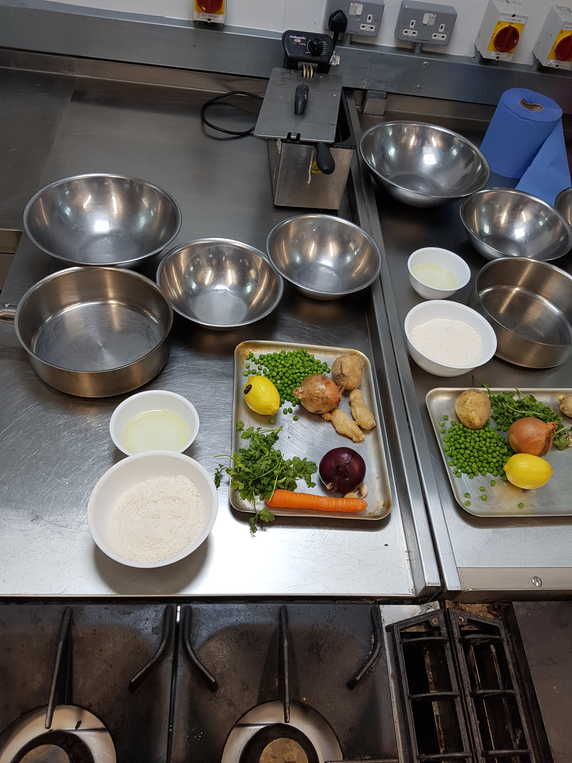
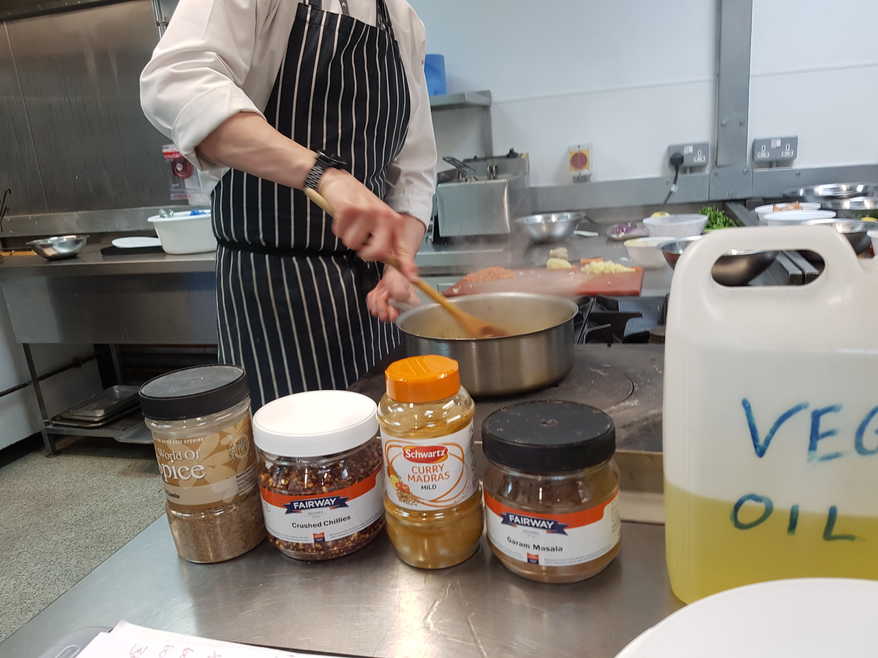
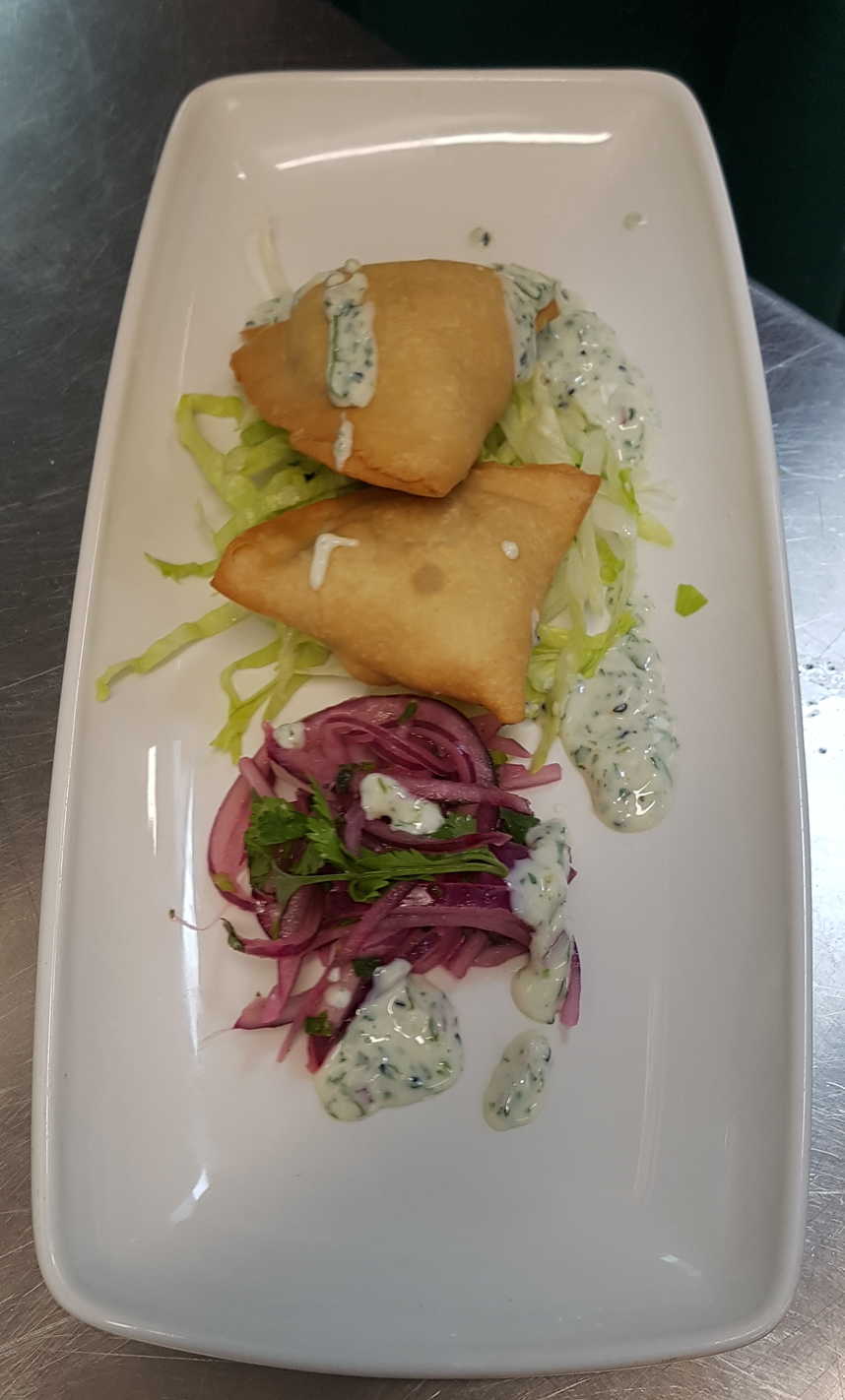
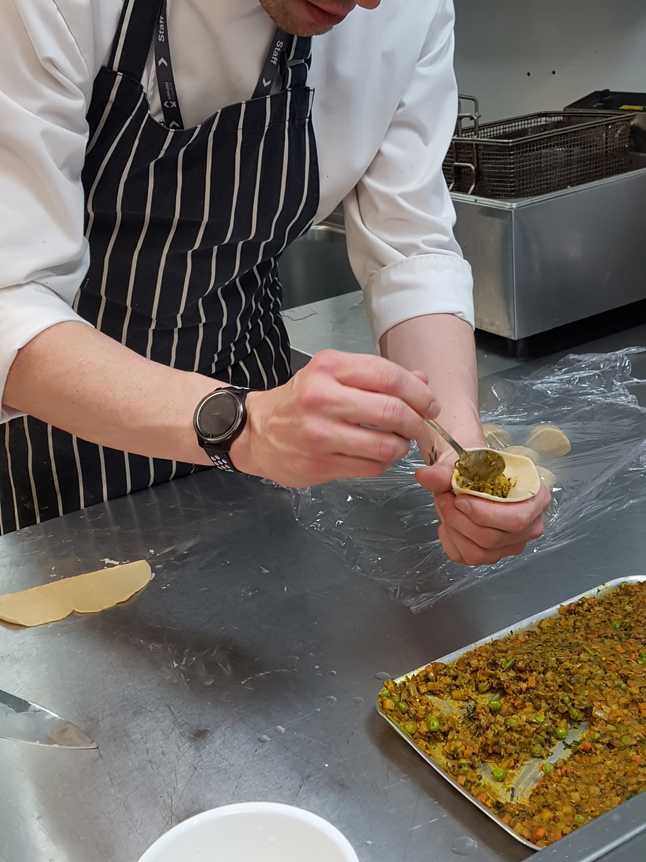
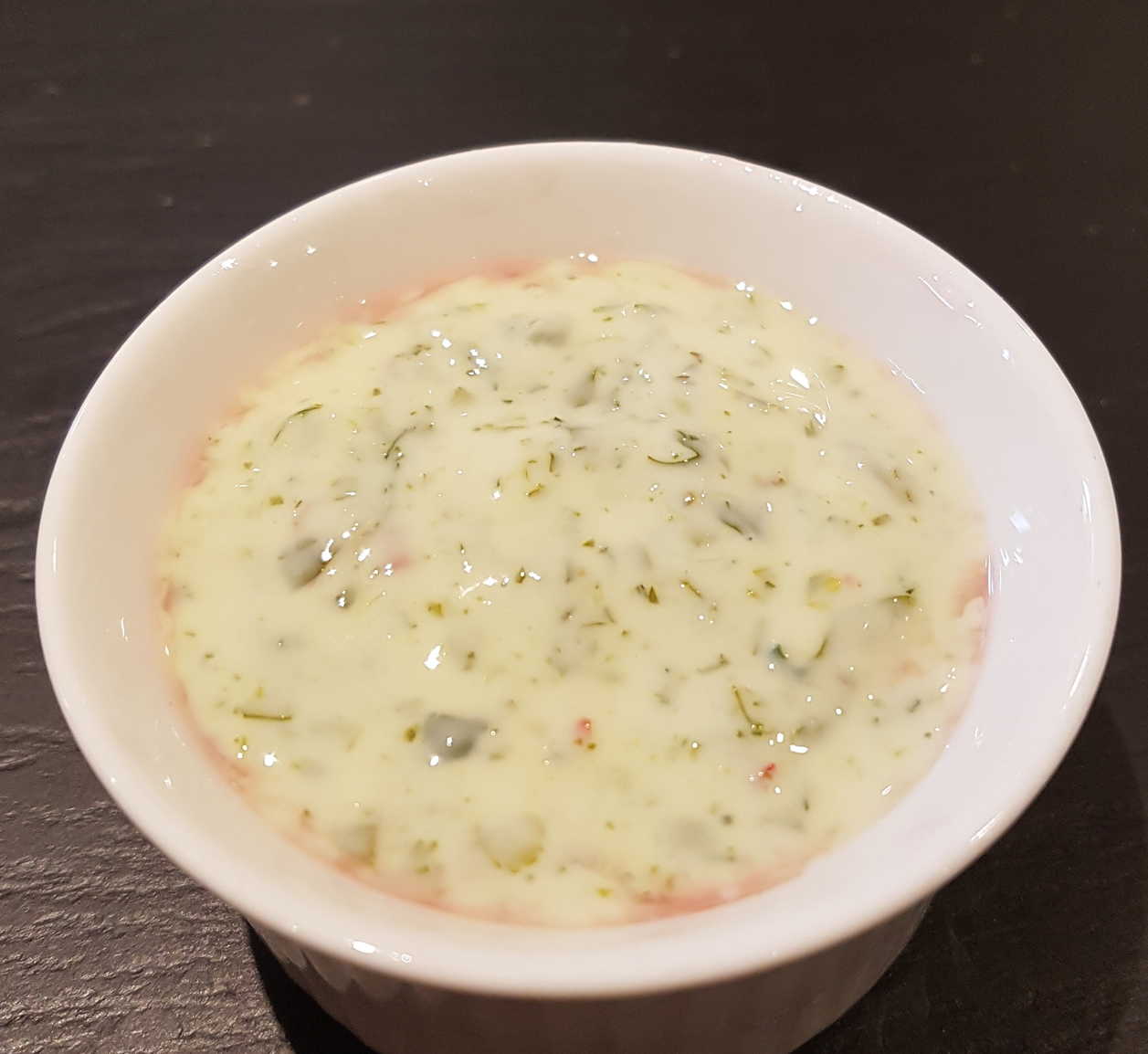
In our case, though, the oil and water were pre-mixed. Well, not actually mixed you understand; they were weighed out in the same bowl.